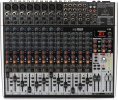Recently, been having an issues with losing audio to stream whenever particularly loud/high pitched sounds go through the mixer. While it does not show as peaking in the Mixer itself, obs appears to be losing audio output and going entirely silent. I know for sure it's not related to anything CPU usage wise, as we rarely are hitting above 15-20% used by OBS.
We are using a Behringer X2222USB Mixer, fed into the PC via a single USB cable, with 6 XLR connected Audio-Technica ATR2100-USB Microphones.
Currently, the only 'solution' to this I've been able to test on my own without having 6 people speaking/laughing at once is to tank the Gain on each mic Mixer to about 25% with Compression at about 50% and the high frequency EQ at around 55-65% (unfortunately I can't give exact numbers, as the mixer doesn't have a digital feed on what the knobs are set to exactly, just generally position along their range). I then have to add about 17.00db of Gain via a Filter in OBS.
We have the VST plugin options with a Noise-Removal profile setup to remove a light hiss in the mic, but on or off the clipping issue still exists so I don't believe that's part of the problem.
With the above changes (Gain ~25%, Comp ~50%, High EQ ~55-65% on Mixer, +17.00db Gain in OBS filter, VST Noise Removal Plugin) I can cause the obs audio to show as over 0.0db / peaking while yelling into the mic and using high pitched voices, but the audio no longer appears to be cutting out when such happens, both in a local recording or stream (tested both ways to ensure no encoding or decoding issues were the culprit).
I did my testing with a singular mic run solo - the issues we have can be triggered solo, but are most often occurring with 6 individuals laughing or speaking into the mic around the same time. Large bursts of audio or high pitched voices seem to trigger things more often.
I have considered a Limiter set at -1.50db but I still can notice it starting to cut or having odd distortion when I get around that level.
Other recommendations on things to attempt to handle sudden bursts of higher then normal volume without causing major distortion or audio to be cut would be much appreciated.
We are using a Behringer X2222USB Mixer, fed into the PC via a single USB cable, with 6 XLR connected Audio-Technica ATR2100-USB Microphones.
Currently, the only 'solution' to this I've been able to test on my own without having 6 people speaking/laughing at once is to tank the Gain on each mic Mixer to about 25% with Compression at about 50% and the high frequency EQ at around 55-65% (unfortunately I can't give exact numbers, as the mixer doesn't have a digital feed on what the knobs are set to exactly, just generally position along their range). I then have to add about 17.00db of Gain via a Filter in OBS.
We have the VST plugin options with a Noise-Removal profile setup to remove a light hiss in the mic, but on or off the clipping issue still exists so I don't believe that's part of the problem.
With the above changes (Gain ~25%, Comp ~50%, High EQ ~55-65% on Mixer, +17.00db Gain in OBS filter, VST Noise Removal Plugin) I can cause the obs audio to show as over 0.0db / peaking while yelling into the mic and using high pitched voices, but the audio no longer appears to be cutting out when such happens, both in a local recording or stream (tested both ways to ensure no encoding or decoding issues were the culprit).
I did my testing with a singular mic run solo - the issues we have can be triggered solo, but are most often occurring with 6 individuals laughing or speaking into the mic around the same time. Large bursts of audio or high pitched voices seem to trigger things more often.
I have considered a Limiter set at -1.50db but I still can notice it starting to cut or having odd distortion when I get around that level.
Other recommendations on things to attempt to handle sudden bursts of higher then normal volume without causing major distortion or audio to be cut would be much appreciated.
